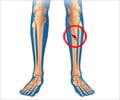Researchers have identified a new gene that is responsible for regulating bone strength and density.

The international study, which involved more than 50 researchers from Europe, North America and Australia and was led by Associate Professor Mattias Lorentzon and Professor Claes Ohlsson at the Sahlgrenska Academy, University of Gothenburg, is based on extensive genetic analyses of the genetic material of 10,000 patients and experimental studies in mice.
Through the combined studies, researchers have succeeded in identifying a special gene, Wnt16, with a strong link to bone density and so-called cortical bone thickness, which is decisive to bone strength.
The genetic variation studied by the international research network could predict, for example, the risk of a forearm fracture in a large patient group of older women.
"In the experimental study, we could then establish that the gene had a crucial effect on the thickness and density of the femur. In mice without the Wnt16 gene, the strength of the femur was up to 61 per cent lower," according to Mattias Lorentzon at the Institute of Medicine, the Sahlgrenska Academy, University of Gothenburg.
The discovery opens up opportunities to develop new medicines to prevent the most common fractures."Low cortical bone mass is a decisive factor in, for example, hip and forearm fractures. Unfortunately, the treatments currently used for brittleness of the bones have very little effect on the cortical bone mass," says Mattias Lorentzon.
Advertisement
Advertisement















